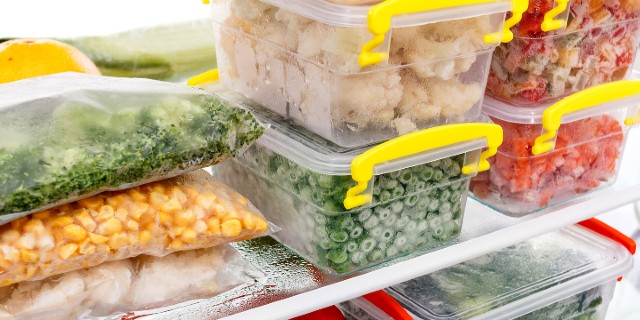How to Move Frozen Food When Moving
Have you ever wondered how to move frozen food when moving? The reality is, moving can be a stressful experience, but when frozen food is thrown into the mix it can become an even bigger headache. Trying to pack and move all of your frozen items without them spoiling or turning bad requires special care to ensure that they stay fresh throughout the entire process.
In this blog post, we will provide you with several tips on how to how to move frozen food when moving. From knowing what kinds of containers are best for keeping perishables cold to utilizing dry ice in certain scenarios, we’ll cover everything you need to know so that you can safely relocate all of your frozen goods in one piece. With that said, let’s get started!

How is Moving Frozen Food Different Than Other Items?
The biggest difference between transporting frozen food and regular items during a move is that you will need to take extra steps to ensure that all of your frozen goods stay cold and safe from spoiling. Since most people don’t have access to moving vans with refrigerators or freezers, it is essential that you find the best ways to keep your food cold during the relocation process.
What Kind of Containers are Best for Moving Frozen Food?
When it comes to transporting frozen food, you will want to make sure that you have the necessary containers before you start packing. The best kind of container for moving frozen food is one that is insulated and has a tight-fitting lid. This will help keep the cold air in and protect your food from any outside elements. Additionally, you can place several layers of newspaper or packing paper on top of the container to further insulate and protect it during transport.
Do I Need Special Equipment to Move Frozen Food?
Depending on the amount of frozen food that you need to move, you may need to invest in special equipment. If you are relocating a large amount of frozen items, having an ice chest on-hand can be incredibly helpful. This will allow you to store all of your frozen food in one place and keep it cold until you reach your final destination. Additionally, if your move is taking more than a few days, you may want to consider investing in dry ice, which can help keep your frozen food cold for an extended period of time.
How to Move Frozen Food When Moving?
If you are planning to move soon, here are the steps to ensure that your move your frozen food properly:
Step #1 – Choose the Right Box or Container When Packing Frozen Food
When packing frozen food, it’s important to select the right type of storage container. A standard cardboard box is not ideal for keeping perishables cold since it won’t provide adequate insulation. Instead, use a hard-sided plastic cooler or Styrofoam shipping container that can be sealed up tight. This will help keep your food cold during the move, as well as prevent any moisture from entering the box and making your food soggy.
Step #2 – Use Sufficient Insulation Around the Food
Once you’ve chosen the right container, it’s time to add insulation around the food. Bubble wrap is a great option for keeping your frozen items insulated, as it will help keep them from getting too warm during transit. If using bubble wrap isn’t an option, newspaper or packing paper can also be used as long as it is placed between layers of food in the box. Additionally, you can use frozen gel packs or ice cubes to keep your food cold for an extended period of time.
Step #3 – Transport Frozen Food with Dry Ice
In cases where you may be moving large amount of frozen items, it’s best to utilize dry ice for optimal preservation. This type of ice is incredibly cold and can last up to several days, which makes it ideal for transporting frozen goods over long distances or longer periods of time. When using dry ice, be sure to place it in a well-ventilated area such as the trunk of your car and make sure there are no open flames nearby. Additionally, you’ll want to wear protective gloves when handling the ice since it can cause serious skin burns.
Tip: If you are transporting a large amount of frozen food during the move, consider renting a cold storage container to transport them in. This type of storage unit is specially designed to keep perishables cold and can be an effective way to transport larger amounts of frozen food.
Step #4 – Label All of Your Boxes Clearly
Lastly, it’s important to clearly label all of your boxes and containers containing frozen food with a permanent marker so that movers and family members will know which items need to be kept cold. This way, everyone will know to keep those boxes in a cool place and handle them with care during the move.
Step #5 – Enjoy Your Frozen Food at Your New Home
Once you’ve successfully moved all of your frozen items, it’s time to enjoy them in your new home! Just make sure to inspect each item for any signs of spoilage or freezer burn before cooking or consuming.
Step #6 (Optional) – Hiring a Moving Company to Help With Your Frozen Food
If you’re feeling overwhelmed by the thought of packing and moving all of your frozen food, consider hiring a professional moving company to help. At Aleks Moving we provide specialized services for transporting perishables and can accommodate to provide refrigerated trucks or extra insulation for fragile items. This way, you don’t have to worry about your frozen food getting spoiled during the move and you can rest assured knowing that it will arrive to its new destination safe and sound. If you’re looking for single item movers Toronto, just call Aleks Moving today!
Conclusion – How to Move Frozen Food When Moving
In conclusion, we hope that you now have learned how to move frozen food when moving and properly pack your perishable items. With that said, it’s time to get started with implementation! Follow these steps and you’ll have all of your perishables safe and sound in no time.
If you need further assistance with moving your perishables, frozen food and next local move, contact us today to get a free quote! Also feel free to check out our additional resources down below!
Happy Moving!

